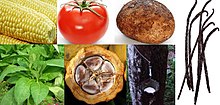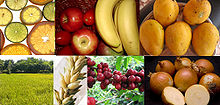Columbian exchange

The Columbian Exchange was a dramatically widespread exchange of animals, plants, food items, human populations (including slaves), communicable diseases, and ideas between the Eastern and Western hemispheres. It was one of the most significant events concerning ecology, agriculture, and culture in all of human history. Christopher Columbus' first voyage to the Americas in 1492 launched the era of large-scale contact between the Old and the New Worlds that resulted in this ecological revolution, hence the name "Columbian" Exchange. The term was coined by Alfred W. Crosby a historian, professor and author, in his 1972 book The Columbian Exchange.
The Columbian Exchange greatly affected almost every society on earth. New diseases introduced by Europeans (many of which had originated in Asia) to which indigenous people had no immunity, depopulated many cultures. Data for the pre-Columbian population in the Americas is uncertain, but estimates of its disease-induced population losses between 1500 and 1650 range between 50 and 90 percent.[1]
On the other hand, the contact between the two areas circulated a wide variety of new crops and livestock which supported increases in population. Explorers returned to Europe with maize, potatoes, and tomatoes, which became very important crops in Eurasia by the 18th century. Similarly, Europeans introduced manioc and the peanut to tropical Southeast Asia and West Africa, where they flourished and supported growth in populations on soils that otherwise would not produce large yields.
Influence

This exchange of plants and animals transformed European, American, African, and Asian ways of life. New foods became staples of human diets, and new growing regions opened up for crops. For example, before AD 1000, potatoes were not grown outside of South America. By the 1840s, Ireland was so dependent on the potato that a diseased crop led to the devastating Irish Potato Famine.[2] Since being introduced by 16th century Portuguese traders, who brought them from the Americas,[3] maize and manioc replaced traditional African crops as the continent’s most important staple food crops.[4] New crops that had come to Asia from the Americas via Spanish colonizers in the 16th century, including maize and sweet potatoes, contributed to the population growth in Asia, too.[5]
One of the first European exports, the horse, changed the lives of many Native American tribes on the Great Plains, allowing them to shift to a nomadic lifestyle based on hunting bison on horseback. Tomato sauce, made from New World tomatoes, became an Italian trademark, while coffee from Africa and sugar cane from Asia became the main crops of extensive Latin American plantations. Introduced to India by the Portuguese, the chili/paprika from South America is today an integral part of Indian cuisine.


Before the Columbian Exchange, there were no oranges in Florida, no bananas in Ecuador, no paprika in Hungary, no tomatoes in Italy, no coffee in Colombia, no pineapples in Hawaii, no rubber trees in Africa, no cattle in Texas, no donkeys in Mexico, no chili peppers in Thailand and India, no cigarettes in France, and no chocolate in Switzerland. The dandelion was brought to America by Europeans for use as an herb.
Of the world's top 20 crops, measured by weight of production in 2007, five (maize, potato, cassava, tomato and sweet potato) originated in the Americas while a sixth, grapes, is most commonly a European plant grafted onto an American rootstock.[6] The remaining Old World origin crops in the top twenty are all grown throughout the world today (cow milk, soybeans, wheat, sugar beet, sugar cane, rice, oranges, onions, sorghum, hen eggs, barley, lettuce and chicory, apples). One-half of the top crop by weight within the United States depends on foods that were first grown in the Americas (but only 39% by value).[7]
Before regular communication had been established between the two hemispheres, the varieties of domesticated animals and infectious diseases, such as smallpox, were strikingly larger in the Old World than in the New, in part because many migrated west or were brought by traders from Asia, so diseases of two continents were suffered by all. "Old World" diseases had a devastating impact on Native American populations because they had no natural immunity to the new diseases. While Europeans and Asians were affected by them, their endemic status in those areas caused some people to build immunity. The smallpox epidemics probably resulted in the largest death tolls for Native Americans.[8]
Examples
| Type of organism | Old World to New World | New World to Old World |
|---|---|---|
| Domesticated animals | ||
| Domesticated plants |
|
|
| Infectious diseases |
Unintentional introductions
In addition to the diseases mentioned above, many species of organisms were introduced to new habitats on the other side of the world accidentally or incidentally. These include such animals as brown rats, earthworms (apparently absent from parts of the pre-Columbian New World), and zebra mussels, which arrived on ships.
Plants also were introduced by chance, including such weeds as tumbleweeds and wild oats. Some plants introduced intentionally, such as kudzu brought from Japan to the United States in 1894 to help control soil erosion, have been found to be invasive pests in the new environment. Even fungi have been transported, such as the one responsible for Dutch elm disease. Some of these species have become serious nuisances upon being established in new environments.
Plants introduced to Europe after 1492 are called Neophytes, whereas plants that made it over the sea before that date are called Archaeophytes.
See also
- Alfred Crosby
- Domestication
- Guns, Germs, and Steel
- Population history of American indigenous peoples
- Pre-Columbian trans-oceanic contact
- Transformation of culture
References
- ^ Shepard Krech, John Robert McNeill, Carolyn Merchant (2004). Encyclopedia of world environmental history, Volume 3. Routledge. p. 1011. ISBN 9780415937351.
{{cite book}}: CS1 maint: multiple names: authors list (link) - ^ "The Impact of the Potato", History Magazine
- ^ "Super-Sized Cassava Plants May Help Fight Hunger In Africa", The Ohio State University
- ^ "Maize Streak Virus-Resistant Transgenic Maize: an African solution to an African Problem", Scitizen, August 7, 2007
- ^ "China's Population: Readings and Maps", Columbia University, East Asian Curriculum Project
- ^ Top Production - world - 2007, UN Food and Agriculture Organization
- ^ Top Production - United States of America - 2007, UN Food and Agriculture Organization
- ^ "The Story Of... Smallpox – and other Deadly Eurasian Germs", Guns, Germs and Steel, PBS
Bibliography
- Crosby, Alfred W., Jr (1972, 2003 reissue). The Columbian Exchange: Biological and Cultural Consequences of 1492;30th Anniversary Edition. Greenwood Publishing Group. ISBN 0275980928.
{{cite book}}: Check date values in:|year=(help)CS1 maint: multiple names: authors list (link) CS1 maint: year (link)
External links
- The Columbian Exchange: Plants, Animals, and Disease between the Old and New Worlds in the Encyclopedia of Earth by Alfred W. Crosby
- Worlds Together, Worlds Apart by Jeremy Adelman, Stephen Aron, Stephen Kotkin, et al.
- New study blames Columbus for syphilis spread from Reuters Jan 15, 2008
- Foods that Changed the World
- The Columbian Exchange study guide, analysis, and teaching guide
- NBC News piece on Columbian Exchange

